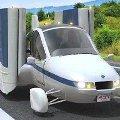Aviator Steve Saint comes from a flying family. His father was a bush pilot in South America, where Saint spent much of his childhood.
Steve Saint "I grew up down in the Amazon jungle in the country of Ecuador where there are no roads, and down there, you either fly or you die," he said. Saint is the founder of a company called "Indigenous Peoples Technology and Education Center," or "I-Tec," which serves people in remote areas isolated from most technology. To get him in and out of some of the roughest terrain on the planet, he turned to an old concept that has remained largely in the human imagination - a flying car. Saint's innovation is called the "Maverick." "This is primarily a car, but you can also fly it, and it only takes a couple of hours to master the flying," he said. Courtesy of I-TecI-Tec's 'Maverick' The Maverick can travel at speeds up to 150 kilometers per hour on a traditional roadway. When it deploys a wing, that looks something like a parachute, it takes off, and can travel up to 100 meters in the air at 65 kilometers an hour.
It might not be very high or very fast, but Saint says the Maverick's function was the driving force behind its development. "People in frontier areas, humanitarian use, mission use, that's our primary focus, but we need to find a commercial market up here [in the United States]," he said. Chief Operating Officer Anna Dietrich of the aircraft company "Terrafugia" believes there is such a market in the U.S. for her company's experimental concept vehicle, called the "Transition." Anna Dietrich "We wanted to show that the same vehicle platform could fly, could drive, could fold up its wings in a reasonable amount of time under a minute, and would be able to park in your garage," she said. The Transition is still an experimental concept vehicle, but it has flown during test flights.
I-Tec's Maverick has also achieved flight during testing. While both are considered major innovations toward bringing the flying car out of the imagination and onto the highways and runways, some pilots and aviation enthusiasts are less than excited about the current design concepts.
"They never will be a really neat-looking car, and they will not be a real efficient airplane. We're asking too much," says John Monnett, the founder of Sonex Aircraft, which is developing an electric-powered sport airplane. He says the flying car concept still has major technological and aesthetic hurdles to overcome.
"It's a novel idea, and time will tell really," he says. "Aircraft have to be built to a different standard than cars, and when you mix the two, what have you got? Something that's mediocre." Terrafugia's Dietrich disagrees. "We feel like we have hit on a compromise that still meets the needs of our customers, still allows you to do more than you would be able to with either a plane or a car as two distinct vehicles," she says. Dietrich says Terrafugia is moving forward into the next phase of developing the Transition. The first commercially available Transition is scheduled for delivery in about 18 months, and the cost to purchase the flying car when it hits the market is estimated at about $200,000.

